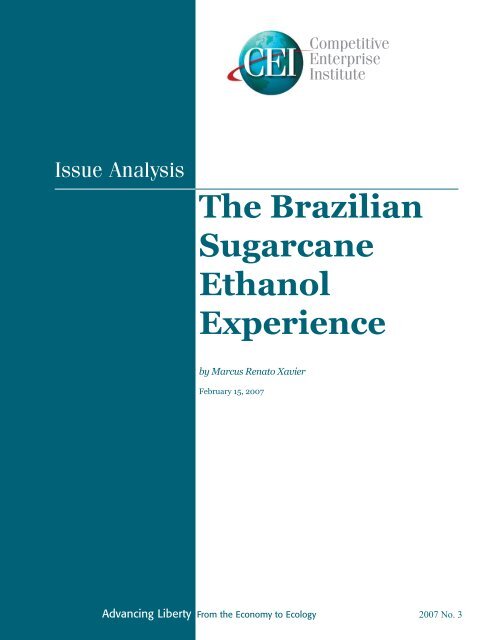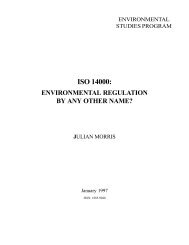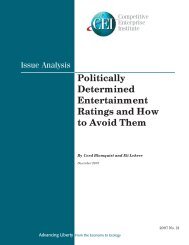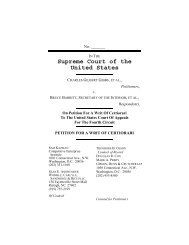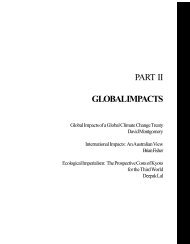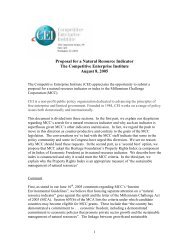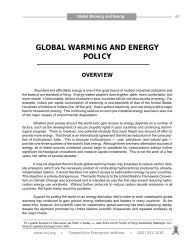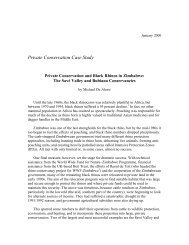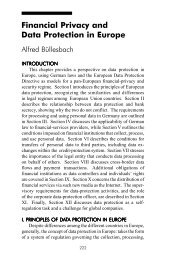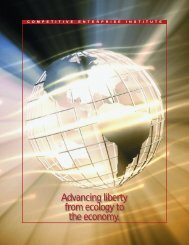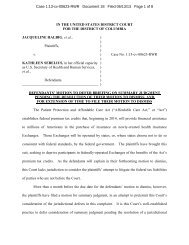The Brazilian Sugarcane Ethanol Experience - AgManager
The Brazilian Sugarcane Ethanol Experience - AgManager
The Brazilian Sugarcane Ethanol Experience - AgManager
You also want an ePaper? Increase the reach of your titles
YUMPU automatically turns print PDFs into web optimized ePapers that Google loves.
Issue Analysis<br />
Advancing Liberty From the Economy to Ecology<br />
Competitive<br />
Enterprise<br />
Institute<br />
<strong>The</strong> <strong>Brazilian</strong><br />
<strong>Sugarcane</strong><br />
<strong>Ethanol</strong><br />
<strong>Experience</strong><br />
by Marcus Renato Xavier<br />
February 15, 2007<br />
2007 No. 3
EXECUTIVE SUMMARY<br />
Xavier: <strong>The</strong> <strong>Brazilian</strong> <strong>Sugarcane</strong> <strong>Ethanol</strong> <strong>Experience</strong><br />
<strong>The</strong> <strong>Brazilian</strong> <strong>Sugarcane</strong><br />
<strong>Ethanol</strong> <strong>Experience</strong><br />
by Marcus Renato S. Xavier<br />
Biofuels are attracting increasing interest around the world. Governments have announced strong commitments<br />
to biofuel programs as a way to both reduce greenhouse gas emissions and diversify energy sources. Advocates<br />
of biofuel subsidies and mandates frequently cite Brazil’s experience with sugarcane-based biomass ethanol as<br />
a success story and model for increasing energy security. Today, Brazil is the world’s largest biofuel market and<br />
<strong>Brazilian</strong> ethanol from sugarcane is arguably the fi rst renewable fuel to be cost-competitive with petroleum fuel<br />
for transport. <strong>The</strong> United States, where most ethanol is produced from corn, is the second largest biofuel market.<br />
However, ethanol production is more economical in Brazil than in the United States. This is due to<br />
several factors, including the superiority of sugarcane to corn as an ethanol feedstock, Brazil’s large unskilled<br />
labor force (sugarcane production is very labor intensive), and a climate ideally suited to growing sugarcane.<br />
While the U.S. and Brazil make about the same volume of ethanol, the U.S. uses almost twice as much land to<br />
cultivate corn for ethanol as Brazil does to cultivate sugarcane for the same purpose, and ethanol fuels a greater<br />
share of Brazil’s cars—there are simply a lot more cars in the United States.<br />
Given Brazil’s natural and acquired advantages for ethanol production, it is diffi cult to imagine the<br />
United States matching Brazil’s level of ethanol consumption—40 percent of the motor fuel market—at a<br />
reasonable economic cost. In the U.S., corn-based ethanol would be viable only if it were to compete in the<br />
market on the same basis as other fuels. American taxpayers today pay twice for ethanol: once in crop subsidies<br />
to corn farmers and again in a 51-cent subsidy for every gallon of ethanol. Without such a subsidy, ethanol<br />
simply would not be cost-competitive with gasoline.<br />
Moreover, corn-based ethanol produced in quantities large enough to displace a signifi cant percentage of U.S.<br />
petroleum consumption could have signifi cant environmental impacts. According to the Worldwatch Institute, ethanol<br />
may damage the environment when it is produced on a large scale from low-yielding crops such as corn. In these<br />
cases it may generate as much or more greenhouse gas emissions than do petroleum fuels. Also, corn-based ethanol<br />
production processing consumes more non-renewable fuels compared to the production of sugarcane ethanol.<br />
Finally, Brazil’s ethanol infrastructure model did not arise from free market competition: It required huge<br />
taxpayer subsidies over decades before it could become viable. <strong>The</strong> ethanol program became uneconomical<br />
when petroleum prices fell in the late 1990s. <strong>The</strong> country’s Congress even resorted to drastic measures by<br />
passing a law forcing oil companies to add small quantities of ethanol to their gasoline (in Brazil, gas sold at<br />
the pumps is 25 percent ethanol). Even today, during a period of high oil prices, volatile ethanol prices have<br />
not freed <strong>Brazilian</strong>s from losing money on the E20 blend mandated by their government. And depending on the<br />
price fl uctuations, sugar growers prefer to make even more money by selling their product as sugar on the world<br />
market rather than fermenting it into alcohol. <strong>The</strong>refore, the <strong>Brazilian</strong> ethanol program is not a suitable model<br />
for U.S. energy policy reform.<br />
1
INTRODUCTION<br />
Biofuels are attracting increasing interest around the world.<br />
Governments have announced strong commitments to biofuel programs<br />
as a way to both reduce greenhouse gas emissions and diversify energy<br />
sources. Advocates of biofuel subsidies and mandates frequently cite<br />
Brazil’s experience with sugar cane-based biomass ethanol as a success<br />
story and model for increasing energy security. Today, Brazil is the world’s<br />
largest biofuel market and <strong>Brazilian</strong> ethanol from sugarcane is arguably<br />
the fi rst renewable fuel to be cost-competitive with a petroleum fuel for<br />
transport. <strong>The</strong> United States, where most ethanol is produced from corn, is<br />
the second largest biofuel market.<br />
<strong>The</strong>se two countries share some important characteristics.<br />
Geographically, both have continental dimensions. Both have great<br />
agricultural capabilities and well-developed domestic automobile<br />
industries. In absolute terms, the <strong>Brazilian</strong> and U.S. fuel ethanol markets<br />
are comparable in size. In 2005, Brazil produced 4,227 million gallons<br />
of ethanol; the United States produced 4,264 million gallons. 1 However,<br />
in biofuels’ market share, the difference is striking. In the United States,<br />
ethanol supplied only 3 percent of total motor fuel consumed in 2005,<br />
while in Brazil, it supplied 40 percent2 .<br />
One reason for this difference is simply the larger overall size of<br />
the U.S. motor fuel market—quite simply, there are a lot more cars in the<br />
United States. In Brazil, there are 23 million vehicles and 49.1 million<br />
households, an average of 0.47 vehicles per household. In the United<br />
States, there are 204 million vehicles for 107 million U.S. households,<br />
an average of 1.9 vehicle per household. 3 Cultural attachment to the<br />
automobile is also different in each country. Unlike in the United States, in<br />
Brazil, cars with small motors of up to 1.4 liters dominate the market.<br />
<strong>Ethanol</strong> production is more economical in Brazil than in the United<br />
States. This is due to several factors, including the superiority of sugarcane<br />
to corn as an ethanol feedstock, Brazil’s large unskilled labor force<br />
(sugarcane production is very labor intensive), and a climate ideally suited<br />
to growing sugarcane. While the U.S. and Brazil make about the same<br />
volume of ethanol, the U.S. uses almost twice as much land to cultivate<br />
corn for ethanol as Brazil does to cultivate sugarcane for the same purpose.<br />
Given these advantages, the productivity and effi ciency of<br />
<strong>Brazilian</strong> sugarcane ethanol production are virtually unmatched by any<br />
other country. So it is far from clear that the United States can or should<br />
attempt to replicate Brazil’s biofuel policies or achievements.<br />
Xavier: <strong>The</strong> <strong>Brazilian</strong> <strong>Sugarcane</strong> <strong>Ethanol</strong> <strong>Experience</strong><br />
<strong>The</strong> productivity and<br />
effi ciency of <strong>Brazilian</strong><br />
sugarcane ethanol<br />
production are<br />
virtually unmatched<br />
by any other country.<br />
3
Even in Brazil, where<br />
climate and labor<br />
market conditions<br />
favor ethanol<br />
production, ethanol is<br />
cost-competitive with<br />
gasoline only during<br />
periods when oil<br />
prices are high.<br />
One objective of this paper is to review the factors that have<br />
contributed to the success of the <strong>Brazilian</strong> bioethanol industry. <strong>The</strong><br />
evolution of this industry offers some valuable lessons for other countries<br />
considering ethanol production. <strong>The</strong> paper will show that even in Brazil,<br />
where climate and labor market conditions favor ethanol production,<br />
ethanol is cost-competitive with gasoline only during periods when oil<br />
prices are high. For the United States, it seems implausible for ethanol<br />
production to have a signifi cant impact on the market for oil, helping<br />
reduce America’s dependence on petroleum.<br />
A Brief History of Brazil’s <strong>Ethanol</strong> Program<br />
Brazil’s National Alcohol Program, PROALCOOL, was launched<br />
in 1975 as a policy to reduce the country’s dependence on oil imports. At<br />
the time, Brazil was importing 80 percent of its oil and the 1973 OPEC oil<br />
embargo and production cutback had raised concerns that oil dependency<br />
could endanger national security. 4<br />
PROALCOOL was both an energy security program and an<br />
agricultural price support program. It aimed to increase production of<br />
sugarcane alcohol for use as a gasoline substitute, but it also sought to<br />
guarantee the profi tability of the sugar industry after the sharp fall in sugar<br />
prices in 1974. <strong>The</strong> program allowed the excess production to be converted<br />
into alcohol (ethanol) in special distilleries close to the sugar mill. <strong>The</strong><br />
ethanol thus produced would be blended with gasoline in a proportion of<br />
up to 24 percent.<br />
As a fi rst step, PROALCOOL aimed to increase the number of<br />
distilleries in the existing mills with the federal government offering<br />
extremely attractive credit guarantees and low-interest loans for<br />
construction of new refi neries. <strong>The</strong>se initial incentives accounted for<br />
nearly $2 billion in loans (nominal dollars) which represented 29 percent<br />
of the total investment needed. 5 <strong>The</strong> principal benefi ciaries of the credit<br />
programs were the large producers. 6<br />
Next, the government began using the state oil company<br />
PETROBRAS to make infrastructure investments for ethanol distribution<br />
and to keep the cost of ethanol to consumers signifi cantly cheaper than<br />
the cost of gasoline. <strong>The</strong> distribution of ethanol by PETROBRAS was<br />
based on a cross-subsidy scheme whereby gasoline prices were artifi cially<br />
boosted to keep the price of ethanol at a competitive level. Through its<br />
involvement in the National Alcohol Program, PETROBRAS accumulated<br />
losses of around $4 billion7 .<br />
4 Xavier: <strong>The</strong> <strong>Brazilian</strong> <strong>Sugarcane</strong> <strong>Ethanol</strong> <strong>Experience</strong>
<strong>The</strong>se incentives were key to the rapid expansion of ethanol<br />
consumption in Brazil. In less than four years, ethanol production more<br />
than tripled8 .<br />
When the Iranian Revolution triggered a second oil crisis in 1979, the<br />
<strong>Brazilian</strong> government expanded PROALCOOL to promote the production<br />
of vehicles especially designed for ethanol use. In the early 1980s, it<br />
signed agreements with major automobile manufacturers—including Fiat,<br />
Volkswagen, Mercedes Benz, General Motors, and Toyota—to increase the<br />
production of ethanol-fueled vehicles. Taxi drivers were given tax breaks to<br />
convert their car engines to run on 100 percent ethanol, and the government<br />
mandated the use of ethanol-fueled vehicles in its own fl eet. As a result,<br />
between 1983 and 1988, ethanol-fueled cars accounted for over 90 percent<br />
of total auto sales. In 1984, ethanol-powered cars accounted for 94.4 percent<br />
of automobile production for the <strong>Brazilian</strong> market9 .<br />
During the second half of the 1980s, however, Brazil’s ethanol<br />
program began to experience problems. Huge fi scal defi cits and high<br />
infl ation led Brazil to start economic reforms that included a cutback on<br />
ethanol production subsidies. At the same time, world oil prices dropped<br />
sharply during 1985-1986, obviating the consumer benefi t of replacing<br />
oil with ethanol. <strong>The</strong> economics became even more unfavorable in 1988<br />
when the world sugar price rose considerably, and, at the same time, the<br />
government liberalized the sugar export market. As a result, sugarcane<br />
planters diverted crops to sugar exports, leading to a severe ethanol<br />
shortage during the second quarter of 1989. In response, the government<br />
authorized ethanol imports, and, ironically, Brazil turned into a net<br />
importer of ethanol. Drivers stopped buying ethanol-fueled cars, and car<br />
manufacturers stopped producing them. By the mid-1990s, only taxis and<br />
rental cars were being produced to run on ethanol. 10<br />
During the 1990s, the <strong>Brazilian</strong> economy experienced profound<br />
transformation. Economic policy emphasized stabilization, privatization,<br />
and liberalization—priorities into which an industrial policy program like<br />
PROALCOOL did not fi t. <strong>The</strong>re was little political support for continued<br />
Xavier: <strong>The</strong> <strong>Brazilian</strong> <strong>Sugarcane</strong> <strong>Ethanol</strong> <strong>Experience</strong><br />
During the second half<br />
of the 1980s, Brazil’s<br />
ethanol program<br />
began to experience<br />
problems. Huge fi scal<br />
defi cits and high<br />
infl ation led Brazil<br />
to start economic<br />
reforms that included<br />
a cutback on ethanol<br />
production subsidies.<br />
5
taxpayer-funded subsidies for sugar growers or distillers. <strong>The</strong> government<br />
gradually rescinded PROALCOOL’s incentives and subsidies and freed<br />
alcohol prices to fl uctuate with the market. Nevertheless, throughout this<br />
period, the federal government continued to require that all gasoline sold<br />
in Brazil contain roughly 20 percent ethanol. <strong>The</strong> government’s rationale<br />
was environmental—ethanol would reduce emissions of lead and other<br />
pollutants. This helped sustain the industry through hard times.<br />
An offi cial evaluation of the total amount of investments in both<br />
the agricultural and industrial sectors for the production of ethanol for<br />
automotive use found that during 1975-1989 the government had spent a<br />
total of $12.3 billion in the National Alcohol Program. 11<br />
Towards the end of 1990s, some <strong>Brazilian</strong> engineers and policy<br />
makers sought to revive the ethanol fuel program. Ford launched its fi rst<br />
fl ex-fuel prototype in 2002, with Volkswagen following in 2003. Flex-fuel<br />
cars able to run on ethanol, gasoline, or any mixture of the two caught<br />
on quickly. By March 2004, fl ex-fuel vehicles represented 16 percent of<br />
new cars sold in Brazil. By February 2006, the fi gure was 73 percent.<br />
(See Figure 1). <strong>The</strong> success of fl ex-fuel cars has led some automakers to<br />
announce plans to extend the technology for the production of all light<br />
vehicles in Brazil.<br />
6 Xavier: <strong>The</strong> <strong>Brazilian</strong> <strong>Sugarcane</strong> <strong>Ethanol</strong> <strong>Experience</strong>
<strong>Ethanol</strong> in Brazil Today<br />
<strong>The</strong> dramatic increase in fl ex-fuel vehicles has helped fuel the<br />
Brazlian sugarcane industry’s recent expansion. Today, Brazil is the<br />
world’s biggest sugar producer and exporter, as well as the world’s largest<br />
producer and consumer of sugarcane ethanol as a transportation fuel. In<br />
2006, Brazil produced 4.2 billion gallons of ethanol. About 85 percent of<br />
the domestic production is concentrated in the Center South of the country<br />
and more than half of it is located in the state of São Paulo. 12<br />
About 80 percent of the country’s total ethanol production is for<br />
domestic consumption, but exports have been growing for several years.<br />
By 2010, <strong>Brazilian</strong> companies are expected to invest about $10 billion in<br />
dozens of new sugar mills to boost ethanol production, while aiming to<br />
double exports.<br />
In Brazil, sugar and ethanol are produced on an integrated basis.<br />
Currently, there are 306 operational mills producing 55 million tons of<br />
sugar or ethanol. <strong>The</strong> option to produce more or less of each product is<br />
infl uenced by the relative prices. When sugar prices increase, for example,<br />
producers can divert sugarcane production from ethanol to sugar. <strong>The</strong><br />
production process also generates 100 million tons of waste—bagasse and<br />
straw— that can be used as fuel for heat and power generation. This is one<br />
signifi cant advantage of sugarcane-based ethanol. Today, <strong>Brazilian</strong> mills<br />
and distilleries are nearly entirely self-suffi cient in energy supply, and a<br />
few even sell surplus electricity.<br />
Xavier: <strong>The</strong> <strong>Brazilian</strong> <strong>Sugarcane</strong> <strong>Ethanol</strong> <strong>Experience</strong><br />
Today, Brazil is the<br />
world’s biggest sugar<br />
producer and exporter,<br />
and the world’s<br />
largest producer<br />
and consumer of<br />
sugarcane ethanol as a<br />
transportation fuel.<br />
7
Under conditions in<br />
Brazil, sugarcane’s<br />
productivity is roughly<br />
twice that of corn-based<br />
ethanol.<br />
Another advantage of sugarcane is its highly favorable energetic<br />
balance when compared with other ethanol sources. Under conditions in<br />
Brazil, sugarcane’s productivity is roughly twice that of corn-based ethanol.<br />
As long as raw material accounts for roughly 60 percent of production costs,<br />
the comparative advantages of sugarcane is crucial to <strong>Brazilian</strong> ethanol’s<br />
commercial feasibility. It is also worth noting that almost all sugarcane<br />
production, which is water-intensive, grows in rain-fed cultivated areas.<br />
<strong>Brazilian</strong> scientists have produced cane varieties that are genetically resistant<br />
to the main crop diseases. <strong>The</strong>re are more than 500 commercial varieties of<br />
cane, of which 20 varieties are used in 80 percent of the cane area13 .<br />
Production costs for ethanol in Brazil are the world’s lowest. <strong>The</strong><br />
average production cost is approximately $ 0.75 per gallon, according<br />
to UNICA, the industry association. Factors contributing to Brazil’s<br />
competitiveness include favorable climate conditions, low labor costs,<br />
and mature infrastructure built over at least three decades. As Figure<br />
3 shows, productivity gains have been substantial. Between 1975 and<br />
2000, modernization of the sugarcane yield per hectare increased by<br />
33 percent and ethanol yield from sugar rose by 14 percent. If ethanol<br />
could also be produced effi ciently from cane bagasse, a process that is<br />
under development in Brazil, future productivity increases could be even<br />
greater14 . <strong>The</strong>se effi ciency gains achieved over a three-decade learning<br />
curve, combined with the aforementioned factors unique to the country,<br />
allow Brazil to sell ethanol close to or below the market price of gasoline.<br />
Unlike the <strong>Brazilian</strong> Alcohol Program’s early days, today the<br />
<strong>Brazilian</strong> sugar program does not rely on any governmental price support<br />
mechanism. <strong>The</strong>re are currently no production subsidies and no indirect<br />
costs paid by other sectors. <strong>The</strong> government’s main intervention is the<br />
aforementioned requirement for all gasoline sold to contain a minimum<br />
percentage of ethanol. This is partly due to environmental rather than<br />
economic concerns. <strong>The</strong> introduction of ethanol as a substitute for lead<br />
additives has helped improve air quality in large cities, particularly São Paulo.<br />
8 Xavier: <strong>The</strong> <strong>Brazilian</strong> <strong>Sugarcane</strong> <strong>Ethanol</strong> <strong>Experience</strong>
As ethanol provides fewer miles per gallon than gasoline, <strong>Brazilian</strong><br />
drivers know that ethanol is price-competitive only when it costs no more<br />
than 70 percent of the price of gasoline. In March 2006, the blending ratio<br />
was reduced from 25 percent to 20 percent after ethanol prices soared to alltime<br />
highs. <strong>Brazilian</strong> drivers stopped using pure ethanol as the price reached<br />
$0.90, about 85 percent of the price of gasoline. Since both sugar ethanol and<br />
oil prices remain volatile, analysts diverge about the trajectory of ethanol as<br />
a fuel in Brazil. <strong>The</strong> beginning of the sugarcane crop season turned ethanol<br />
cost-competitive with gasoline, at least in the regions near the production<br />
areas. In the North and Northeast of Brazil, high transportation costs still limit<br />
the economic viability of using ethanol as fuel.<br />
Xavier: <strong>The</strong> <strong>Brazilian</strong> <strong>Sugarcane</strong> <strong>Ethanol</strong> <strong>Experience</strong><br />
As ethanol provides<br />
fewer miles per<br />
gallon than gasoline,<br />
<strong>Brazilian</strong> drivers know<br />
that ethanol is pricecompetitive<br />
only when<br />
it costs no more than<br />
70 percent of the price<br />
of gasoline.<br />
9
At the prevailing exchange rate of U$1 = R$2.15, average price of<br />
gasoline (E20) in São Paulo was US$4.20 per gallon while ethanol was<br />
US$2.70. At these prices <strong>Brazilian</strong> drivers still benefi t using ethanol. In<br />
Rio de Janeiro, gasoline is still more economical than ethanol.<br />
Conclusion and Some Lessons from Brazil<br />
Given Brazil’s natural and acquired advantages for ethanol<br />
production, it is diffi cult to imagine the United States matching Brazil’s<br />
level of ethanol consumption—40 percent of the motor fuel market—at a<br />
reasonable economic cost. In the U.S., corn-based ethanol would be viable<br />
only if it were to compete in the market on the same basis as other fuels.<br />
American taxpayers today pay twice for ethanol: once in crop subsidies to<br />
corn farmers and again in a 51-cent subsidy for every gallon of ethanol.<br />
Without such a subsidy, ethanol simply would not be cost-competitive<br />
with gasoline.<br />
Corn-based ethanol produced in quantities large enough to displace<br />
a signifi cant percentage of U.S. petroleum consumption could have<br />
signifi cant environmental impacts. According to the Worldwatch Institute, 15<br />
ethanol may damage the environment when it is produced on a large scale<br />
from low-yielding crops such as corn. In these cases it may generate as<br />
much or more greenhouse gas emissions than do petroleum fuels.<br />
10 Xavier: <strong>The</strong> <strong>Brazilian</strong> <strong>Sugarcane</strong> <strong>Ethanol</strong> <strong>Experience</strong>
A point rarely noted in discussions of the <strong>Brazilian</strong> biofuel program<br />
is that, along with ethanol, oil self-suffi ciency has been a long-term goal<br />
of the <strong>Brazilian</strong> government. After the crisis with PROALCOOL during<br />
the late 1980s, the <strong>Brazilian</strong> government, through PETROBRAS, has put<br />
much more emphasis on increasing oil production. Based on its excellent<br />
performance on offshore exploration, PETROBRAS increased oil<br />
production by an average of 9 percent per year since 1980, in the range of<br />
1.8 million barrels per day. In 2006, Brazil achieved self-suffi ciency in oil<br />
and expects to export an estimated 500,000 bpd by 2010.<br />
If ethanol were truly key in displacing oil imports, the <strong>Brazilian</strong><br />
ethanol program also shows that biofuels should not be considered a<br />
panacea for the world’s energy challenges. Brazil’s ethanol infrastructure<br />
model required huge taxpayer subsidies over decades before it could<br />
become viable. <strong>The</strong> ethanol program became uneconomical when<br />
petroleum prices fell in the late 1990s. Even today, during a period of high<br />
oil prices, ethanol volatile prices have not freed <strong>Brazilian</strong>s from losing<br />
money on the E20 blend mandated by their government. <strong>The</strong> <strong>Brazilian</strong><br />
ethanol program is not a suitable model for U.S. energy policy reform.<br />
NOTES<br />
Xavier: <strong>The</strong> <strong>Brazilian</strong> <strong>Sugarcane</strong> <strong>Ethanol</strong> <strong>Experience</strong><br />
Brazil’s ethanol<br />
infrastructure model<br />
required huge<br />
taxpayer subsidies<br />
over decades before it<br />
could become viable.<br />
1 F.O. Licht Database 2006, http://www.agra-net.com/portal<br />
2 Masami Kojima and Todd Johnson. Potential for Biofuel for Transport in Developing Countries. Energy Sector Management<br />
Assistance Programme. World Bank, October 2005. Pg. 1.<br />
3 Leslie Miller. Cars, trucks now outnumber drivers. Salon. 29 August 2003.<br />
http://www.salon.com/tech/wire/2003/08/29/cars_and_drivers/index.html<br />
4 Petrobras (Petróleo Brasileiro S.A.) 2006. Data from www.petrobras.com.br.<br />
5 J. R. Moreira and J. Goldemberg. “<strong>The</strong> Alcohol Program.” Energy Policy 27 (1999) 229-245. Pg. 232<br />
6 Masami Kojima and Todd Johnson. Op cit. Pg. 48.<br />
7 J. R. Moreira and J. Goldemberg. Op. cit. Pg. 235.<br />
8 Jaime Buarque de Hollanda and Alan Douglas Poole. <strong>Sugarcane</strong> as an Energy Source in Brazil. INEE. pg.2<br />
www.inee.org.br/down_loads/forum/SUGARCANE&ENERGY.pdf<br />
9 ANFAVEA (Associação Nacional dos Fabricantes de Veículos Automotores) 2006. Data from www.anfavea.com.br.<br />
10 Jaime Buarque de Hollanda and Alan Douglas Poole. Op. cit.. Pg.4.<br />
11 J. R. Moreira and J. Goldemberg. Op.cit. Pg 229.<br />
12 Unica (União da Agroindústria Canavieira de São Paulo), 2002. Data from www.unica.com.br<br />
13 Plínio M. Nastari. “Informativo Datagro” Report on the cane, sugar and alcohol industry, São Paulo, Brazil, 2005, Numbers 1. Pg.12<br />
14 Goldemberg, José, Suani Teixeira Coelho, Plinio Mário Nastari, and Oswaldo Lucon. 2004. “<strong>Ethanol</strong> Learning Curve—the<br />
<strong>Brazilian</strong> <strong>Experience</strong>.” Biomass & Bioenergy 26: 301–304.<br />
15 Worldwatch Institute. Biofuels for Transportation: Global Potential and Implications for Sustainable Energy in the 21st Century.<br />
May 4, 2006.<br />
11
About the Author<br />
Marcus Renato S. Xavier is an economist at the Federation of Industries of the State of Minas Gerais and<br />
Professor of Economics at IBMEC Business School and Fundação João Pinheiro. He received his B.A in<br />
Economics from Federal University of Minas Gerais and his Master degree from the University of São Paulo.<br />
He is also a senior fellow at Instituto Liberdade.<br />
<strong>The</strong> fi ndings, interpretations, and conclusions expressed in this paper are entirely those of the author and should<br />
not be attributed in any manner to those organizations<br />
12 Xavier: <strong>The</strong> <strong>Brazilian</strong> <strong>Sugarcane</strong> <strong>Ethanol</strong> <strong>Experience</strong>
$8.00<br />
<strong>The</strong> Competitive Enterprise Institute is a non-profit public policy organization dedicated<br />
to the principles of free enterprise and limited government. We believe that<br />
consumers are best helped not by government regulation but by being allowed to<br />
make their own choices in a free marketplace. Since its founding in 1984, CEI has<br />
grown into an influential Washington institution.<br />
We are nationally recognized as a leading voice on a broad range of regulatory<br />
issues ranging from environmental laws to antitrust policy to regulatory risk. CEI is<br />
not a traditional “think tank.” We frequently produce groundbreaking research on<br />
regulatory issues, but our work does not stop there. It is not enough to simply identify<br />
and articulate solutions to public policy problems; it is also necessary to defend<br />
and promote those solutions. For that reason, we are actively engaged in many<br />
phases of the public policy debate.<br />
We reach out to the public and the media to ensure that our ideas are heard, work<br />
with policymakers to ensure that they are implemented and, when necessary, take<br />
our arguments to court to ensure the law is upheld. This “full service approach” to<br />
public policy makes us an effective and powerful force for economic freedom.<br />
Competitive<br />
Enterprise<br />
Institute<br />
1001 Connecticut Avenue, NW<br />
Suite 1250<br />
Washington, DC 20036<br />
202-331-1010<br />
Fax 202-331-0640<br />
www.cei.org<br />
Issue Analysis is a series of policy studies published by the Competitive Enterprise Institute. Nothing in Issue<br />
Analysis should be construed as necessarily reflecting the views of CEI or as an attempt to aid or hinder the<br />
passage of any bill before Congress. Contact CEI for reprint permission. Additional copies of Issue Analysis<br />
may be purchased through CEI’s publications department (pubs@cei.org or 202-331-1010).


